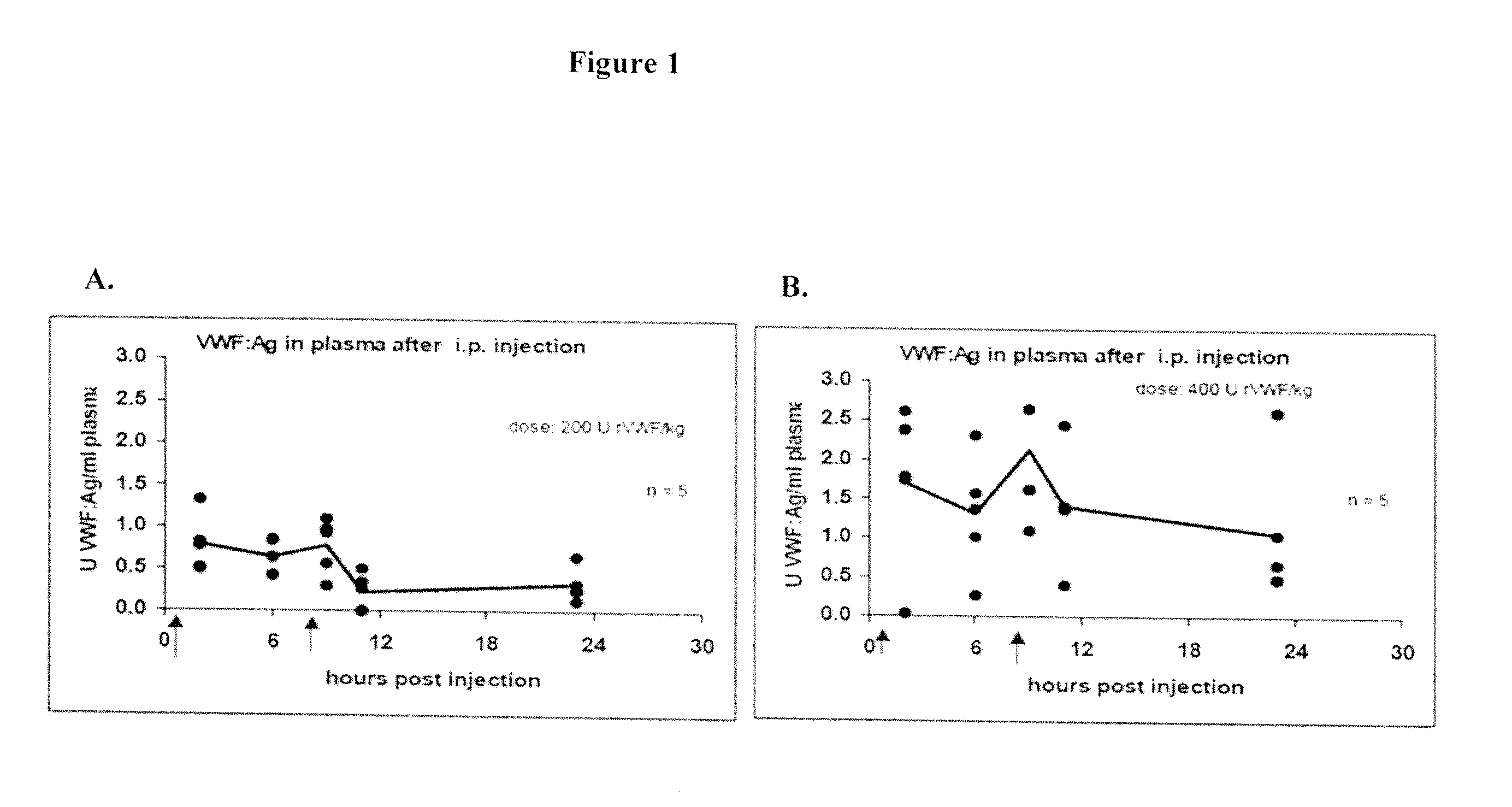Transgenic Mouse Lacking Endogenous FVIII and VWF - A Model of Hemophilia A
a mouse and endogenous technology, applied in the field of transgenic nonhuman animals lacking factor viii, can solve the problems of increased blood coagulation tendency, inability to clot, and vwf also directly interfere with blood coagulation, and achieve the effect of improving clinical readou
- Summary
- Abstract
- Description
- Claims
- Application Information
AI Technical Summary
Benefits of technology
Problems solved by technology
Method used
Image
Examples
example 1
Effect of Exogenous VWF on FVIIIxVWD Double Knockout Mice
[0107]Mouse models of human hemophilia A and von Willebrand disease (VWD) have been used for pharmacokinetic, pharmacodynoamic and immunological studies of FVIII or VWF. FVIII deficient mice lack FVIII protein but carry normal levels of endogenous mouse VWF, which might interact differently with infused human FVIII than human VWF. Therefore a mouse model with FVIII deficiency and with human VWF instead of murine VWF would be advantageous for the study of hemophilia. In order to study the effects of human VWF in hemophilia, a transgenic mouse line was established based on mice deficient in both endogenous FVIII and VWF (FVIIIxVWD).
[0108]Intravenous injection of human VWF was not an effective option for bringing the VWF-FVIII co-deficient mice back to normal circulating levels of VWF over time due to the relatively short half-life of human VWF in vivo in these animals (approximately 5 hours). As such, an alternative method of de...
example 2
Administration of FVIII / VWF Complex to FVIIIxVWD Knockout Mice
[0115]The finding that intact VWF multimers were observed after i.p. injection of rVWF or pdVWF into mice lacking VWF led to the investigation of whether a complex of human rFVIII and rVWF could also be administered by i.p injection with a similar outcome.
[0116]Combinations of each of 200 IU rFVIII / kg and 200 IU VWF:Ag / kg were injected i.p. in the same treatment intervals as described above. Analysis of blood as above demonstrated that circulating VWF:Ag levels were detectable for up to 24 hours, similar to animals treated with VWF alone (FIG. 5). FVIII levels measured at the same timepoints showed that FVIII was detectable at 0.1±0.6 units / ml after 3 hours and maintained this level up to 9 hours. FVIII was not detectable after 24 hours (FIG. 6). For these experiments, recovery of VWF after i.p. injection was approximately 12% of injected material while FVIII recovery was approximately 5%. In a repeat experiment, blood le...
example 3
Assessment of Exogenous Human VWF on Blood Clotting in FVIIIxVWD Knockouts
[0119]Similar to human hemophilia, FVIIIxVWD double knockout mice present with a tendency to have bleeding episodes. Administration of exogenous human VWF to FVIIIxVWD double knockout mice demonstrated that intraperitoneal, and to a lesser extent subcutaneous, injection of rVWF or pdVWF allows for VWF to be transported into the vasculature and demonstrated detectable activity in the circulation. This observation indicates that the exogenous VWF likely exhibits characteristic VWF activity in vivo, including attracting platelets to the site of vascular injury, mediating platelet-platelet interaction, and stabilizing Factor VIII (FVIII) in the circulation (Plaimauer et al., Semin Thromb Hemost. 27:395-403, 2001).
[0120]Collagen is a physiological binding partner of VWF. Studies by Kessler et al. (Blood 63:1291-1298, 1984) have shown that the complex of VWF and Factor VIII binds to collagen fibrillae. U.S. Pat. No....
PUM
| Property | Measurement | Unit |
|---|---|---|
| Adhesion strength | aaaaa | aaaaa |
| Therapeutic | aaaaa | aaaaa |
Abstract
Description
Claims
Application Information
 Login to View More
Login to View More - R&D
- Intellectual Property
- Life Sciences
- Materials
- Tech Scout
- Unparalleled Data Quality
- Higher Quality Content
- 60% Fewer Hallucinations
Browse by: Latest US Patents, China's latest patents, Technical Efficacy Thesaurus, Application Domain, Technology Topic, Popular Technical Reports.
© 2025 PatSnap. All rights reserved.Legal|Privacy policy|Modern Slavery Act Transparency Statement|Sitemap|About US| Contact US: help@patsnap.com



